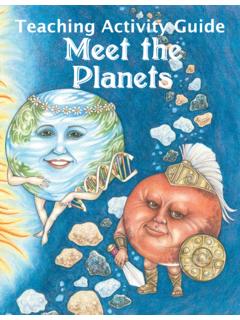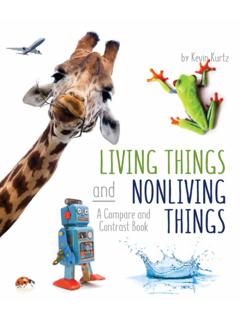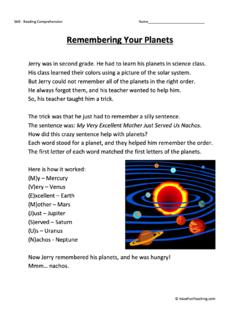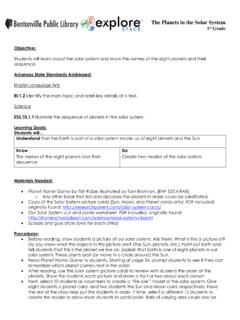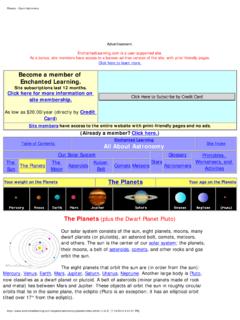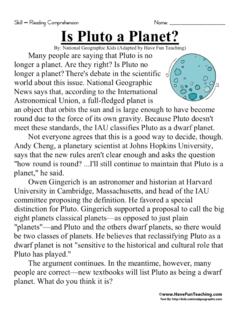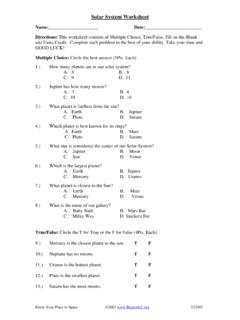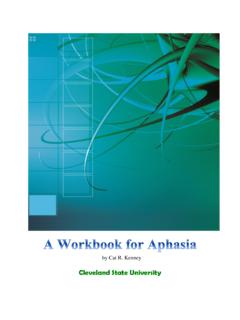Transcription of Meet the Planets - Arbordale Publishing
1 Meet thePlanetsby John McGranaghanillustrated by Laurie Allen KleinJohn McGranaghanLaurie Allen KleinJohn McGranaghan has always been fascinated by outer space and he shares that fascination in a humorous (but educational) way through Meet the Planets and saturn for My Birthday. John has also written stories and articles for Boys Quest Magazine, Pockets Magazine, Columbia Magazine, and local newspapers. He is winner of the 2001 Pockets Fiction Contest. When John isn t writing, he enjoys sports and spending time with his wife and two boys. John is a school counselor in the Philadelphia suburbs. Laurie Allen Klein has been a freelance artist for nearly 20 years. Over the last several years, she has worked as the on-staff artist for a marine park, where she does everything from painting life-size sea animal murals, to illustrating children s activity books.
2 As evident by the extras included in the art, she has combined her love and fascination with outer space (and science fiction) with children s illustration in Meet the Planets . Laurie also illustrated Furs and Feathers, Where Should Turtle Be?, Solar Forecast, the award-winning Little Skink s Tail, and If a Dolphin Were a Fish for Arbordale . Laurie lives in Florida. Soar into the Solar System to witness the first Favorite planet Competition, emceed by none other than the former ninth planet , now known as dwarf planet Pluto. Who will the lucky winning planet be? Readers learn all about each planet as Pluto announces them with short, tongue-in-cheek facts. Children (of all ages) will spend hours searching the art for all the references to famous scientists and people of history, space technology, constellations, art, and classic literature.
3 It s so much more than a picture book .. this book is specifically designed to be both a fun-to-read story and a launch pad for discussions and learning. Whether read at home or in a classroom, we encourage adults to do the activities with the children in their lives. Free online resources and support for the book at include: For Creative Minds as seen in the book (in English & Spanish): And the Winner Is .. Time and Temperatures Distance from Sun: A Place Value Activity Constellations, Famous People, Space Technology Solar System: True or False? Teaching Activities: reading Questions Math Language Arts Geography Science Coloring Pages Interactive Quizzes: reading comprehension , For Creative Minds, and Math Word Problems English and Spanish Audiobooks Related Websites Aligned to State Standards (searchable database) Accelerated Reader and reading Counts!
4 Quizzes Lexile and Fountas & Pinnell reading LevelseBooks with Auto-Flip, Auto-Read, and selectable English and Spanish text and audio available for purchase to Dr. Curt Niebur, Program Scientist, Planetary Division, NASA; Dr. Susan Niebur of Niebur Consulting; Dr. Art Hammon, Program Coordinator, CSU-NASA/JPL Education Initiative, NASA/JPL (Jet Propulsion Laboratory); and to Brian Kruse, Lead Formal Educator at the Astronomical Society of the Pacific for verifying the accuracy of the information in this John McGranaghanillustrated by Laurie Allen KleinMeet thePlanetsMeet thePlanetsWelcome to the first ever, Favorite planet Competition. I m your host, Pluto, coming to you live from the Solar System inside the beautiful Milky Way Planets have been around for billions of years.
5 They have been viewed through telescopes and visited by spaceships. And tonight, one will be named the favorite planet !Without further ado .. let s meet the Planets !MercuryVenusEarthMarsSaturnJupit erNeptuneUranusThey re solid. They re rocky. They re close to the sun. Here come the inner s a little bigger than Earth s moon and covered in craters; but make no mistake, he s all planet . Circling the sun in just 88 Earth days, he s the fastest moving planet in the Solar System. He s named after the speedy messenger of the gods; now you see him, now you don t .. meet Mercury!The For Creative Minds educational section may be photocopied or printed from our website by the owner of this book for educational, non-commercial uses. Cross-curricular teaching activities, interactive quizzes, and more are available online.
6 Go to and click on the book s cover to explore all the Creative MindsWhich planet do YOU think should be the Solar System s favorite planet ? Why?Ask your friends, family members, and classmates which is their favorite planet . And the Winner is ..MercuryVenusEarthMarsJupiterSaturnUran usNeptunePlanets are not to nightsunlightnewmoonfullmoonwaxing crescent waxing gibbousfirst quarterwaning crescent last quarterwaning gibbousThere are so many fun ways to incorporate math and science skills into learning about the solar system! Please see the free online teaching activities for more solar system fun. MercuryVenusEarthMarsJupiterSaturnUranus NeptuneHow many votes?1-56-10 Copy or download this page from the internet (see above). Please do not write in the book!
7 Keep track of the answers using tally marks. For every answer, draw an up and down (vertical) line. Every 5th line should cross the four before it. Count the tally marks to see who the winner is and then graph the results. Our months come from the almost 30 days it takes the moon to revolve around the Earth. The first day of a lunar month is the day of the new moon, when the sun and moon rise at approximately the same time. The moon rises about 50 minutes later each day as it goes through its phases.*The rounded lengths of time are shown in Earth time around Sun*Rotates on its axis*Mercury88 days59 daysVenus225 days243 days one dayMars687 daysone dayJupiter12 years10 hoursSaturn29 years10 1/2 hoursUranus84 years17 hoursNeptune165 years16 hoursDo you notice a pattern between inner versus outer Planets and the amount of time it takes them to rotate or revolve?
8 How long would a day be on the other Planets ?How long would a year be on other Planets ?Food for thought: How long would a month be on a planet with no moon or with more than one moon? How would YOU determine how many months or how many days in a month? What would you call them? Our day of 24 hours comes from the approximate amount of time it takes the Earth to rotate (spin) on its axis (a make-believe stick going through the Earth from the North to South Poles). Our year (365 days) comes from the approximate amount of time it takes the Earth to revolve (orbit) around the Sun. We add a leap day every four years (leap year) to even out the extra and TemperaturesFind the planet symbol to identify the planet s average , Famous People, and Space TechnologyThere are art references in this book to constellations, famous people, space technology, classic books, and even other art.
9 Can you find the art in the book? What are some other things you see in the art? A detailed explanation of what is what and who is who can be found in the books online activities. True/False Answers: 1. False: the outer Planets are gas with no soil; 2. False: there may be water frozen on ice on some of the other Planets (or on their moons), but scientists have not (yet) found liquid water on any Planets ; 3. True; 4. False: Mars atmosphere has carbon dioxide, not oxygen; 5. True: a day is the amount of time it takes the planet to rotate on its axis; 6. True: a year is the amount of time it takes the planet to revolve around the Sun; 7. False: the inner Planets are rocky and the outer Planets are gaseous; 8. False: Depending on where the moon is in its cycle, we can see it during the day System True or False QuestionsUse information found in the book to answer the following true/false questions.
10 Answers are upside down at the bottom of the page. Distance From Sun: A Place-Value ActivityAnswer the following place-value questions. Answers are upside down at the bottom of the page. For more place value and decimal activities, see the book s online Answers: 1, Earth; 2, Neptune; 3, Uranus; 4, 108,000,000; 5, three: Neptune, saturn 6, ten millions place; 7, five ten thousands or fifty thousand; 1. Which planet s distance has the highest digit in the ten thousands column? 2. Which planet s distance has the highest digit in the ten millions column? 3. Which planet s distance has the highest digit in the hundred millions column? 4. If you were to round to the millions, how far would it be in kilometers to Venus? 5. How many Planets are over a billion kilometers from the sun?
